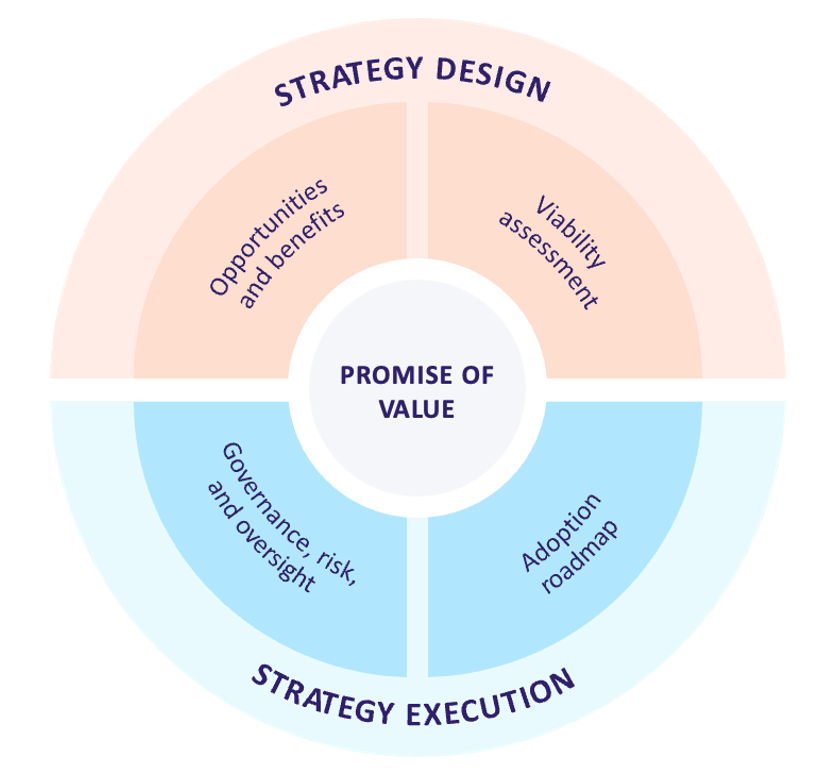
Buying Technology is not an AI Strategy: How to drive sustainable AI adoption in HR
Artificial intelligence (AI) has become part of the HR vocabulary. No longer a future ambition, many HR teams have been exploring why, how, and where AI could be used to unlock productivity, enhance capabilities, and deliver new value, as well as which technologies can deliver on this.
However, buying technology or licenses is not an AI strategy.
More than 60% of HR professionals say they do not integrate AI into their practices beyond individual productivity. This approach to adoption has led to many leaders questioning the value of AI, asking, “Is the AI hype worth the investment?”
In this article, we explore the reality of AI adoption and highlight the critical success factors for sustainable adoption.
Why Adoption and Integration Is So Hard
To fully harness AI's potential, HR has to move beyond task-based applications and towards deeper integration. This involves embedding AI into core HR processes, using it to inform decision-making, and leveraging it to drive strategic change. Understanding the current barriers is a starting point for this adoption and integration journey.
Our data show that both individual and organizational factors influence the appetite and extent to which AI is adopted within HR.
At the individual level, three factors influence how HR professionals use AI:
- Exposure and opportunity to use AI: Confidence and competence develop through use. Where HR professionals don’t have access to or use AI tools in their roles, adoption stalls.
- Organizational signals and support: HR professionals use AI if it is a priority in the business and support is provided. If AI isn’t seen as a priority or is used sporadically, it’s unlikely to gain traction in HR.
- Sentiment: Feelings matter. Excitement, fear, and skepticism all influence how HR professionals engage with AI, even when tools are available.
At the organization level, HR teams face other challenges that impact adoption. HR leaders often struggle to articulate AI's value to the organization, which impacts buy-in, investment, and leadership sponsorship. HR teams also struggle to identify the proper use cases to apply AI and determine whether those use cases are viable. Gaining leadership buy-in becomes more complicated when the impact isn’t clear, and without a strong governance framework, execution feels risky.
Adopting a structured approach to AI value creation
We’ve developed an AI readiness framework to help HR teams to overcome the challenges they face in driving adoption. The framework consists of four interrelated components centered around the promise of value.

Defining the Promise of Value
Any successful AI strategy begins with a clear promise of value. Rather than adopting AI for experimentation, HR leaders should start by answering a fundamental question: Why should we use AI in the first place?
This anchors AI adoption in a compelling business case, focusing on real value rather than novelty. Key questions to explore include:
- Why do we want to use AI?
- Where can AI generate value, and are those areas critical to our business?
- How can AI help us achieve our strategic objectives?
The promise of value should articulate the outcomes AI can support - whether efficiency, enabling faster and better decision-making, enhancing employee experiences, or accelerating service delivery.
From Value to Opportunity: Identifying Where AI Can Make a Difference
Once the value is defined, it is translated into concrete opportunities. This involves identifying specific use cases where AI could make an impact. Start as wide as possible, building a comprehensive list of potential applications across your HR ecosystem.
Then, shift from possibilities to practicality. Evaluate each use case based on three key criteria:
- Affordability: What is the cost of implementation?
- Viability: Is it technically and operationally feasible?
- Value realization: How well does it deliver on the promised outcomes?
This process turns a broad list into a strategic shortlist of viable, high-impact AI applications that align with your business priorities.
From Strategy to Execution: Turning Intent into Action
The final phase of the framework moves from planning to doing, focusing on enabling successful implementation. Execution is built on two pillars:
- Governance, risk, and oversight structures: Strong governance ensures AI is deployed ethically, transparently, and responsibly. It builds trust with stakeholders and safeguards against unintended consequences.
- An AI adoption roadmap: A phased roadmap translates strategy into action. It outlines the steps for implementation, supported by proper training, change management, and stakeholder engagement - ensuring adoption is sustainable and scalable.
This structured approach allows HR leaders to move beyond the hype toward a meaningful, business-aligned AI strategy.
Final Words
Being AI-ready isn’t just about knowing what the tools can do. It’s about learning how to use them to drive real value for HR professionals, the HR function, and the organization. The question is not whether AI will impact HR - it already has.
About the Authors
Dr. Marna van der Merwe
Dr. Marna van der Merwe is an Organizational Psychologist and leads the Thought Leadership and Insights Practice at the Academy to Innovate. She has over 15 years of experience in Human Resources, Employee Experience, Organizational Effectiveness, and Strategic Talent Management. She is a researcher, published author, and regular conference speaker on the future of work, the impact of AI on work, talent management, experience design, and the changing nature of careers.
Dr. Dieter Veldsman
Dr. Dieter Veldsman is the Chief HR Scientist at the Academy to Innovate HR and a Professor of Practice at the University of Johannesburg. He is an organizational psychologist with 17+ years of experience across the HR value chain and lifecycle, having worked for and consulted with various organizations in EMEA, APAC, and LATAM. He has held the positions of Group Chief People Officer, Organizational Effectiveness Executive, Director of Consulting Solutions, and Chief Research Scientist. He is a regular speaker on the topics of Strategic HR, Future of Work, AI in HR, Employee Experience and Organisational Development.
The views and opinions expressed in this blog post belong solely to the original author(s) and do not necessarily represent the views and opinions of CPHR Alberta.





